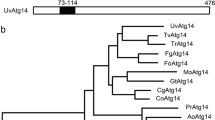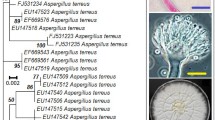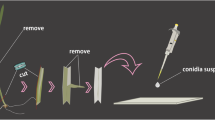Abstract
Autophagy is a highly conserved pathway that mediates bulk degradation of cellular components in lysosomes/vacuoles and plays an important role in filamentous fungi by impacting growth, morphology and development. However, in leaf rust, the role of autophagy is poorly understood. In this study, we identified the structure of autophagy in leaf rust infection structures by using transmission electron microscopy (TEM). The results suggest that autophagy can be strongly induced in the haustorium mother cell (HMC) but did not occur in other special infection structures, such as the appressorium, substomatal vesicle and haustorial. Applying the autophagy inhibitor 3-mehyladenine (3-MA) to leaf rust resulted in significant arrest of mycelial growth and delays in leaf rust infection. These results suggest that autophagy can be induced in HMC and is important for fungal infection of wheat. This research will help us to expand our understanding of the physiological functions of autophagy in filamentous fungi.









Similar content being viewed by others
References
Ashford, T. P., & Porter, K. R. (1962). Cytoplasmic components in hepatic cell lysosomes. The Journal of Cell Biology, 12, 198–202.
Aubert, S., Gout, E., Bligny, R., Marty-Mazars, D., Barrieu, F., Alabouvette, J., Marty, F., & Douce, R. (1996). Ultrastructural and biochemical characterization of autophagy in higher plant cells subjected to carbon deprivation: control by the supply of mitochondria with respiratory substrates. The Journal of Cell Biology, 133, 1251–1263.
Bassham, D. C., Laporte, M., Marty, F., Moriyasu, Y., Ohsumi, Y., Olsen, L. J., & Yoshimoto, K. (2006). Autophagy in development and stress responses of plants. Autophagy, 2, 2–11.
Gutierrez, M. G., Master, S. S., Singh, S. B., Taylor, G. A., Colombo, M. I., & Deretic, V. (2006). Autophagy is a defense mechanism inhibiting BCG and Mycobacterium tuberculosis survival in infected macrophages. Cell, 119, 753–766.
Howard, R. J., & Valent, B. (1996). Breaking and entering: host penetration by the fungal rice blast pathogen Magnaporthe grisea. Annual Review of Microbiology, 50, 491–512.
Kikuma, T., Ohneda, M., Arioka, M., & Kitamoto, K. (2006). Functional analysis of the ATG8 homologue Aoatg8 and role of autophagy in differentiation and germination in Aspergillus oryzae. Eukaryotic Cell, 5, 1328–1336.
Klionsky, D. J. (2005). The molecular machinery of autophagy: unanswered questions. Journal of Cell Science, 118, 7–18.
Klionsky, D. J. (2007). Autophagy: from phenomenology to molecular understanding in less than a decade. Nature Reviews Molecular Cell Biology, 8, 931–937.
Levine, B., & Klionsky, D. J. (2004). Development by self-digestion: molecular mechanisms and biological functions of autophagy. Developmental Cell, 6, 463–477.
Liu, X. H., Lu, J. P., & Lin, F. C. (2007a). Autophagy during conidiation, conidial germination and turgor generation in Magnaporthe grisea. Autophagy, 3, 472–473.
Liu, X. H., Lu, J. P., Zhang, L., Dong, B., Min, H., & Lin, F. C. (2007b). Involvement of a Magnaporthe grisea serine/threonine kinase gene, MgATG1, in appressorium turgor and pathogenesis. Eukaryotic Cell, 6, 997–1005.
Liu, G., Hou, C. Y., & Wang, D. M. (2010). Calcium influx is required for the initiation of the hypersensitive response of Triticum aestivum to Puccinia recondita f.sp. tritici. Physiological and Molecular Plant Pathology, 74, 267–273.
Lu, J. P., Liu, X. H., Feng, X. X., Min, H., & Lin, F. C. (2009). An autophagy gene, MgATG5, is required for cell differentiation and pathogenesis in Magnaporthe oryzae. Current Genetics, 55, 461–473.
Mizushima, N. (2007). Autophagy: process and function. Genes & Development, 21, 2861–2873.
Panwar, V., McCallum, B., & Bakkeren, G. (2013). Host-induced gene silencing of wheat leaf rust fungus Puccinia triticina pathogenicity genes mediated by the Barley stripe mosaic virus. Plant Molecular Biology, 81, 595–608.
Pinan-Lucarré, B., Paoletti, M., Dementhon, K., Coulary-Salin, B., & Clavé, C. (2003). Autophagy is induced during cell death by incompatibility and is essential for differentiation in the filamentous fungus Podospora anserina. Molecular Microbiology, 47, 321–333.
Pinan-Lucarré, B., Balguerie, A., & Clavé, C. (2005). Accelerated cell death in Podospora autophagy mutants. Eukaryotic Cell, 4, 1765–1774.
Pollack, J. K., Harris, S. D., & Marten, M. R. (2009). Autophagy in filamentous fungi. Fungal Genetics and Biology, 46, 1–8.
Rohringer, R., Kim, W. K., Samborski, D. J., & Howes, N. K. (1977). Calcofluor: an optical brightener for fluorescence microscopy of fungal plant parasites in leaves. Phytopathology, 67, 808–810.
Rose, T. L., Bonneau, L., Marty-Mazars, C., Der, D., & Marty, F. (2006). Starvation-induced expression of autophagy-related genes in Arabidopsis. Biology of the Cell, 98, 53–67.
Seay, M., Patel, S., & Dinesh-Kumar, S. P. (2006). Autophagy and plant innate immunity. Cellular Microbiology, 8, 899–906.
Seglen, P. O., & Gordon, P. B. (1982). 3-Methyladenine: specific inhibitor of autophagic lysosomal protein degradation in isolated rat hepatocytes. The Proceedings of the National Academy of Sciences USA, 79, 1889–1892.
Staples, R. C. (2001). Nutrients for a rust fungus: the role of haustoria. Trends in Plant Science, 6, 496–498.
Szabo, L. J., & Bushnell, W. R. (2001). Hidden robbers: the role of fungal haustoria in parasitism of plants. The Proceedings of the National Academy of Sciences USA, 98, 7654–7655.
Takeshige, K., Baba, M., Tsuboi, S., Noda, T., & Ohsumi, Y. (1992). Autophagy in yeast demonstrated with proteinase-deficient mutants and conditions for its induction. The Journal of Cell Biology, 119, 301–311.
Talbot, N. J., & Kershaw, M. J. (2009). The emerging role of autophagy in plant pathogen attack and host defence. Current Opinion in Plant Biology, 12, 444–450.
Thompson, A. R., & Vierstra, R. D. (2005). Autophagic recycling: lessons from yeast help define the process in plants. Current Opinion in Plant Biology, 8, 165–173.
Tucker, S. L., & Talbot, N. J. (2001). Surface attachment and prepenetration stage development by plant pathogenic fungi. Annual Review of Phytopathology, 39, 385–417.
Veneault-Fourrey, C., Barooah, M., Egan, M., Wakley, G., & Talbot, N. J. (2006). Autophagic fungal cell death is necessary for infection by the rice blast fungus. Science, 312, 580–583.
Xiong, Y., Contento, A. L., Nguyen, P. Q., & Bassham, D. C. (2007). Degradation of oxidized proteins by autophagy during oxidative stress in Arabidopsis. Plant Physiology, 143, 291–299.
Yorimitsu, T., & Klionsky, D. J. (2005). Autophagy: molecular machinery for self-eating. Cell Death and Differentiation, 12, 1542–1552.
Acknowledgments
This research was supported by the National Natural Science Foundation of China (No.31171472), the Natural Science Foundation of Hebei Province (No. C2012204045) and the Science and Technology research Project of Colleges and Universities of Hebei Province (No. Q2012097).
Author information
Authors and Affiliations
Corresponding author
Ethics declarations
Conflict of interest
The authors declare that they have no conflict of interest.
Open access
This article is distributed under the terms of the Creative Commons Attribution License which permits any use, distribution, and reproduction in any medium, provided the original author(s) and the source are credited.
Rights and permissions
About this article
Cite this article
Liu, G., Tian, D., Shi, C. et al. Autophagy is induced in haustorial mother cells of Puccinia triticina and is necessary for plant infection. Eur J Plant Pathol 147, 833–843 (2017). https://doi.org/10.1007/s10658-016-1047-y
Accepted:
Published:
Issue Date:
DOI: https://doi.org/10.1007/s10658-016-1047-y




